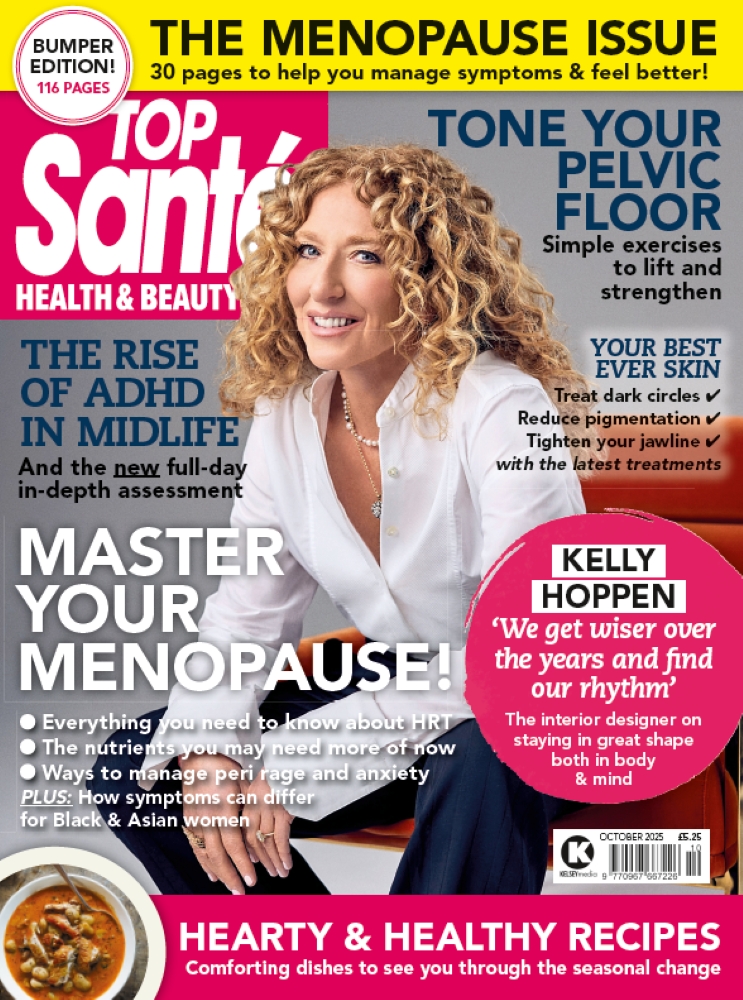Your HbA1c score is a key indicator of long-term blood sugar balance. We asked three wise women to share their expert lifestyle tips for lowering it and reducing your risk of diabetes.
Images: Shutterstock, Unsplash
The HbA1c test, often referred to as the glycated haemoglobin test, is a crucial marker of blood-sugar regulation. It reflects average blood glucose levels over the previous two to three months.
While commonly associated with diabetes management, elevated HbA1c can also signal metabolic disturbances that have far-reaching effects, particularly for women’s hormonal and overall health.
For women, lowering HbA1c is about more than preventing diabetes, it’s a gateway to optimal health, improved mood, weight, skin, sleep, fertility, and vitality. Women are uniquely vulnerable to the effects of dysregulated blood sugar, especially during key hormonal transitions such as puberty, pregnancy, perimenopause, and menopause.
With blood-sugar imbalances and the pre-diabetic state, insulin resistance can: Disrupt ovulation and fertility. Exacerbate symptoms of polycystic ovary syndrome (PCOS). Aggravate menopausal symptoms such as hot flushes, anxiety, brain fog and fatigue.
Contribute to weight gain, particularly around the abdomen. Drive chronic inflammation, which underpins a variety of hormonal disorders. Optimising HbA1c and balancing blood sugars can be a powerful way to support hormonal balance, energy, mood, and long-term health.
One of the most important decisions we make on a daily basis is what to eat. The food choices we make have an impact on our immediate health as well as our long-term health. Small steps in the right direction make a big difference! Here are five ways to support your blood-sugar balance and overall health:

Pauline says…
1. Prioritise protein and healthy fats. Start each meal with protein and fats to stabilise blood sugar. This helps prevent post-meal sugar spikes, which can elevate HbA1c over time. Healthy options include: Oily fish including sardines, mackerel, anchovies, salmon; grass-fed meat; eggs; organic tofu or tempeh; flaxseed and ahiflower oils; olives and olive oil; avocados and avocado oil.
2. Choose fibre-rich, low-glycaemic carbohydrates. Fibre slows sugar release, supporting better blood sugar balance and gut health, so swap out high-GI foods such as bread and pastries for slower-digesting carbohydrates, including: legumes such as lentils and chickpeas; quinoa; beans such as edamame beans, which provide a great source of protein and moderate carbs; root vegetables and leafy greens; dark berries and citrus fruit.
3. Balance blood sugar with meal timing. Avoid grazing. Eat 2-3 balanced meals a day with 4-5 hours between meals to allow insulin levels to fall. Time-restricted eating or intermittent fasting can also benefit some women, particularly during perimenopause, though individual tolerance varies.
4. Try supplements for HbA1c support. Key nutrients that support insulin sensitivity and glycaemic control include: Magnesium bisglycinate – enhances insulin receptor sensitivity. Zinc – crucial for insulin production and glucose metabolism. Alpha-lipoic acid (ALA) – supports mitochondrial energy and reduces oxidative stress. Berberine – natural compound shown to lower HbA1c in studies. Ahiflower oil – a rich source of omega-3 SDA, GLA to support hormonal balance and ALA, supporting inflammation and metabolic health. British-grown ahiflower oil is found in Regenerative Omegas (£29.99, in all good independent health food shops). Always check with your GP before starting supplements, especially if taking medication.
5. Manage stress and sleep. Chronic stress raises cortisol, which can elevate blood sugar. Sleep deprivation also impairs insulin sensitivity. Aim for 7-9 hours of quality sleep, plus daily movement (e.g. walking, resistance training, yoga), and also include breathwork, journaling, or mindfulness practices to down-regulate the nervous system.
Pauline Cox is a functional nutritionist. Her latest book is Hungry Woman: Eating For Good Health, Happiness + Hormones. She runs health food store and café Sow and Arrow near Bristol (sowandarrow.com). Follow her at instagram.com/paulinejcox.

Kate says…
When facing elevated HbA1C or early signs of pre-diabetes, one of the most effective tools we have at our disposal is movement. As a personal trainer, I’ve witnessed how consistent and intentional exercise can significantly change a person’s health trajectory. (For more information on how strength training can reduce diabetes risk, tap here.)
It’s not just about increasing activity; it’s about participating in movements that effectively support blood sugar regulation and metabolic health. It is advisable to begin lifting weights if you aren’t already. Muscle plays a crucial role in how your body utilises insulin.
It acts like a glucose sponge: the more lean muscle tissue you have, the more effectively your body can eliminate sugar from the bloodstream. Strength training two to four times a week can greatly enhance insulin sensitivity, assist in maintaining a healthy metabolism, and support overall energy levels.
This can involve bodyweight exercises, resistance bands, or free weights – and consistency and progression remain essential. Beyond structured workouts, what you do throughout the day matters. Small bursts of movement, especially after meals, can help reduce blood-sugar spikes and support steady energy levels.
Whether it’s going for a 10-minute walk, stretching between tasks, taking the stairs, or even standing during phone calls, these small moments of movement accumulate. It’s not about perfection; it’s about creating a lifestyle that fosters balance and consistency.
Gentle, steady-state activities like walking, cycling, or swimming can help manage stress and support cardiovascular health – both important factors in blood sugar control. Additionally, they are highly accessible and easy to incorporate into your routine, irrespective of your fitness level.
These forms of movement promote recovery and lower cortisol, which can be particularly helpful if you’re navigating fatigue or just getting started with regular exercise.
There’s a common misconception that exercise has to be extreme to be effective, but that’s simply not true. Especially when it comes to blood sugar regulation, the goal isn’t to burn off excess glucose with high-intensity punishment. Instead, we want to create a responsive, efficient, and balanced body.
That means prioritising recovery, managing stress, and respecting your energy levels while still showing up for movement. Movement is medicine. When done with intention and consistency, it becomes one of the most empowering and sustainable ways to support your blood sugar, energy, and long-term health.
Whether you’re responding to a recent blood test or simply looking to take proactive steps toward better health, exercise is one of the most accessible and effective places to start.
Kate Rowe-Ham is a PT specialising in helping midlife women get strong and feel good. She’s the founder of app Owning Your Menopause (owningyourmenopause.com) and a patron of the Menopause Mandate. Follow her at instagram.com/katerh_fitness.

Suzy says…
It can be a real shock to learn the news of a test score and diagnosis like this, so be gentle with yourself. Make space for the very normal and natural thoughts and feelings you have in response; it could be everything from disbelief, to anger, to grief.
Give yourself time to process how you feel about it and gather the information that you need to formulate your nourishing action plan. Reach out and talk to your family, your friends and your healthcare professionals for support in navigating this. What do you need to know and who can support you in gaining clarity on your next steps?
We know that quitting smoking, limiting alcohol, regular movement and healthy eating can have a powerful impact on reversing prediabetes, but let’s be honest, it can be hard to commit to healthy habits at the best of times. While it is necessary to be clear on the supportive lifestyle changes you might need to make, take it slowly and aim for sustainable, incremental waves of change.
Stress can also affect your blood-sugar levels, so it’s important you know how to identify your early warning signs and you will need a broad toolkit of soothing practices to help you manage your energy, your emotions and your mood. Healthy eating, decent hydration and exercise will all help you manage your stress, as will prioritising your sleep and rest needs.
A simple practice to help you feel more in tune with yourself is to put a hand on your heart while you are drinking water. Make it a ritual of checking in with yourself, feeling how the gesture of “hand on heart” helps you extend a little more tenderness towards yourself.
As you do, ask yourself: ‘Where am I at? What do I need? How can I resource myself?’
Notice how this practice can help you take replenishing action before those other tell-tale signs of stress let you know that you need some TLC. If you’re not sure where to start with restorative practices, pick up my book Rest To Reset.
The good news is that committing to one healthy habit is likely to have a knock-on effect, paving the way for other supportive choices. Think about which habit might be this helpful domino for you. Pick one and make that your focus.
For many people, that domino habit is starting the day with exercise, helping you feel more energetic during the day, boosting willpower and helping you sleep better at night, but equally, it could be a journaling habit or breathing practice. See what works for you and know that I am willing you on.
Suzy Reading is a chartered psychologist and author of Self-Care For Tough Times and latest book Self-Care For Winter (both Aster). She specialises in helping people better manage their energy, emotions and stress. Find her at suzyreading.co.uk and at instagram.com/suzyreading.








